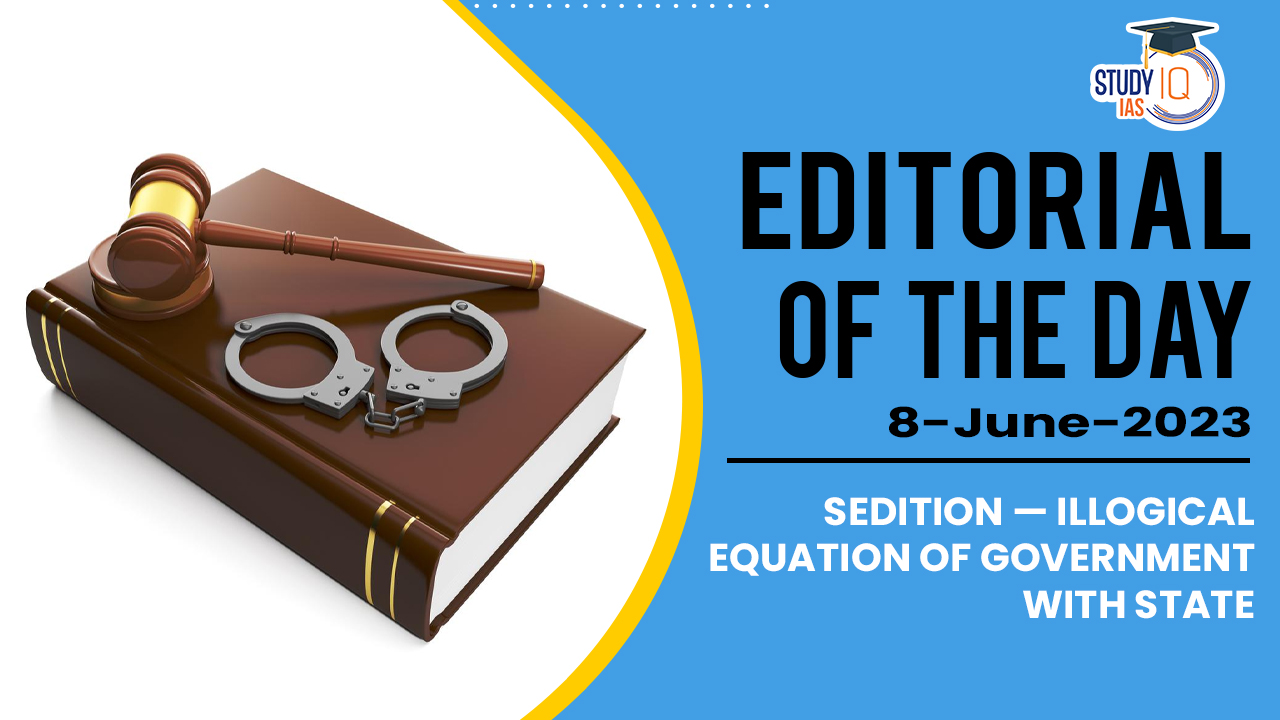Table of Contents
Context: The article delves into the Law Commission of India’s suggestion to maintain and strengthen the penalties for the offence of sedition as outlined in Section 124A of the Indian Penal Code. It provides an overview of the historical background of the sedition law, originally designed to stifle dissent against the British Raj. It explores the differing interpretations of sedition during the British era, one defining it as disaffection or political hatred towards the government and the other emphasizing incitement to violence or disorder. The article argues that the sedition law contradicts the fundamental right to freedom of speech and expression and questions the constitutional validity of the law. It criticizes the Law Commission’s recommendation to enhance punishment, dismissing it as out of touch with the widespread demand for the abolition of the law.
Sedition – Illogical Equation of Government with State Background
What is Sedition?
- Sedition under IPC 124A is defined as an attempt to bring in hatred or contempt or excites or attempts to excite disaffection towards the government established according to the law.
- The expression “disaffection” includes disloyalty and all feelings of enmity.
- Comments expressing disapprobation of Government measures with a view to obtain their alteration by lawful means, without exciting hatred, contempt or disaffection, will not constitute an offence under this section;
- Comments expressing disapprobation of the administrative or Government action without exciting hatred, contempt or disaffection, will not constitute an offence under this section.
- Punishment:
- It is a non-bailable law that is punishable with imprisonment from three years up to life, along with a fine.
- Individuals charged under the law will be barred from a government job and their passport is seized by the government.
Recent recommendations of the Law Commission on Sedition
- Incorporating the Kedarnath Judgement: The Law Commission report states that the essence of Kedarnath v State of Bihar (1962) needs to be incorporated in Section 124A.
- Kedarnath upheld the constitutionality of the Sedition Law stating that it falls within the ‘reasonable restrictions’ on freedom of speech mentioned under Article 19(2) of the Constitution.
- The Court ruled that the offence of sedition can be established when the words or actions tend to incite violence or lead to public disorder.
- However, the report states that Section 124A, as it currently reads, fails to clearly cull out the meaning of these actions, resulting in its vague interpretation.
- Installing a New Procedural ‘Safeguard’
- The Commission recommends a major procedural amendment to the Code of Criminal Procedure, 1973 (CrPC) to prevent the ‘alleged misuse’ of the law.
- It suggests that a police officer, holding the rank of an Inspector or higher, must conduct a preliminary inquiry before the First Information Report (FIR) is filed.
- Subsequently, based on the findings of the inquiry report, the Central Government may or may not grant permission to file an FIR.
- This amendment is to be made to Section 154 of the CrPC.
- The Law Commission highlights that this recommendation was made after taking into consideration the observations of the Supreme Court in S.G. Vombatkere regarding the potential misuse of the law.
- Increasing the term of punishment:
- The Commission recommends enhancing the punishment to a period of seven years or life imprisonment, along with a fine.
- Currently, the punishment is a period of imprisonment of either three years or life imprisonment.
- The report describes this punishment as ‘odd’ as there is a discrepancy among other provisions found in Chapter VI of IPC, which lists the ‘Offences against the State’.
- Inserting New Words in the Provision:
- The Report recommends the insertion of the words ‘tendency to incite violence or cause public disorder’ in the provision.
- It defines ‘tendency’ as an ‘inclination to incite violence or public disorder rather than proof of actual violence or imminent threat to violence’.
- Thus, the consequence of an action won’t be considered if ‘inclination’ is established.
- The Report highlights that Kedarnath established that proof of violence is not necessary to establish the offence of sedition.
- Instead, the Judgement primarily relies on the tendency of the words or actions to incite violence or disturb public order
Decoding the Editorial
Historical background of the sedition law
- The author asserts that a brief journey into the British era is necessary to better understand the judgment in Kedarnath vs State of Bihar (1962) by the Supreme Court and the Law Commission’s recommendations for incorporating the essence of that judgment.
- The law of sedition in India has a long and infamous history. Section 124A was incorporated in the Indian Penal Code in 1870.
- The purpose was to suppress the voice of Indians who spoke against the British Raj, as the government did not want any voice of dissent or protest.
- The author held that the wording of Section 124A clearly reflects the colonial government’s intention to silence dissent and prevent any form of protest.
- The author emphasize that sedition is an offence directed against the government and not against the country itself, contrary to common belief.
- The offence involves inciting hatred, contempt, or disaffection towards the lawfully established government through spoken or written words, signs, or any other means.
Differing interpretations of sedition during the British era
- The author discusses the different interpretations of sedition during the British era in India. The article mentions two significant cases that shaped the understanding of sedition at that time.
- Queen Empress vs Bal Gangadhar Tilak 1897:
- In this case, the Bombay Court found Tilak guilty of sedition for writing a couple of articles in Kesari, a Marathi weekly, which was interpreted as exciting disaffection towards the British government.
- The interpretation in this case defined sedition as exciting or attempting to excite bad feelings or political hatred towards the government, even without inciting rebellion or violence.
- The author highlights that this interpretation of sedition was also upheld by the Privy Council, which was the highest appellate court that served as the final court of appeal for the British Empire and its colonies, including India.
- Niharendu Dutt Majumdar And Ors. vs Emperor 1942:
- This case was decided by the Federal Court. In this case, the court acquitted the accused and defined sedition as involving public disorder or the anticipation of such disorder.
- The author has highlighted these contrasting interpretations of the law of sedition given by two different courts during British India.
- One interpretation defines sedition as disaffection or ‘political hatred of government’ and considers it to fall within the purview of sedition.
- The other interpretation restricts the offence to cases involving incitement to violence or disorder.
- The author points out that though the court’s interpretation in Tilak’s case was approved by the Privy Council, the opinion was not brought to the attention of the Federal Court when it decided the case of Niharendu Dutt Majumdar. Otherwise, it would have followed the Privy Council’s decision.
The constitutionality of sedition
- The author discusses Kedarnath vs State of Bihar (1962) which dealt with the constitutionality of sedition, and the Supreme Court held that sedition is constitutionally valid for two reasons.
- Firstly, it stated that sedition, although an offence against the government, is also an offence against the state, as the government represents the state.
- Secondly, the court invoked Article 19(2) of the Indian Constitution, which allows for restrictions on the freedom of speech and expression in the interest of the security of the state.
- The author challenges the reasoning of the Supreme Court in the Kedarnath case.
- He argues that equating the government with the state is illogical in a democratic republic and that disaffection towards a government should not be criminalized as it is a legitimate part of the democratic process.
- The author asserts that sedition violates the fundamental right to freedom of speech and expression guaranteed under Article 19(1)(a) of the Indian Constitution.
- The author contends that the Kedarnath judgment did not bring any significant changes to the sedition law. Instead, it brought it closer to the interpretation in the Tilak case without alleviating the severity of the law.
Author on Law commission’s suggestions
- The author is critical of the Law Commission’s suggestion to incorporate the “tendency to incite disorder” in Section 124A of the sedition law.
- He argues that the definition of “tendency” as a slight inclination gives significant power to law enforcement officials, allowing them to subjectively determine whether a speech or article has the potential to incite disorder.
- This broad interpretation can result in citizens being imprisoned for seven years or even for life.


 TNPSC Group 4 Admit Card 2025 Out at tnp...
TNPSC Group 4 Admit Card 2025 Out at tnp...
 Species Added to India's Flora and Fauna...
Species Added to India's Flora and Fauna...
 Daily Quiz 02 July 2025
Daily Quiz 02 July 2025





















